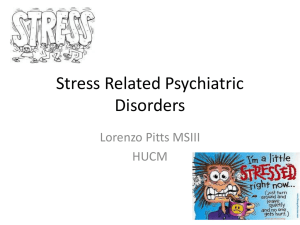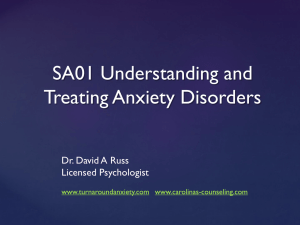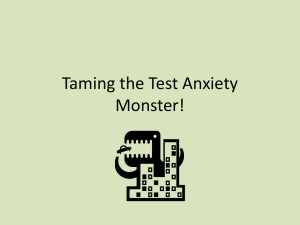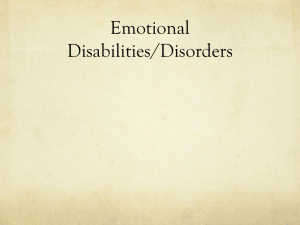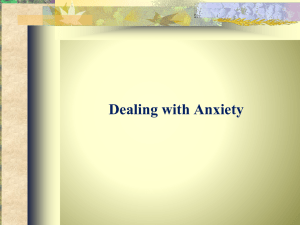Durand and Barlow Chapter 4: Anxiety Disorders
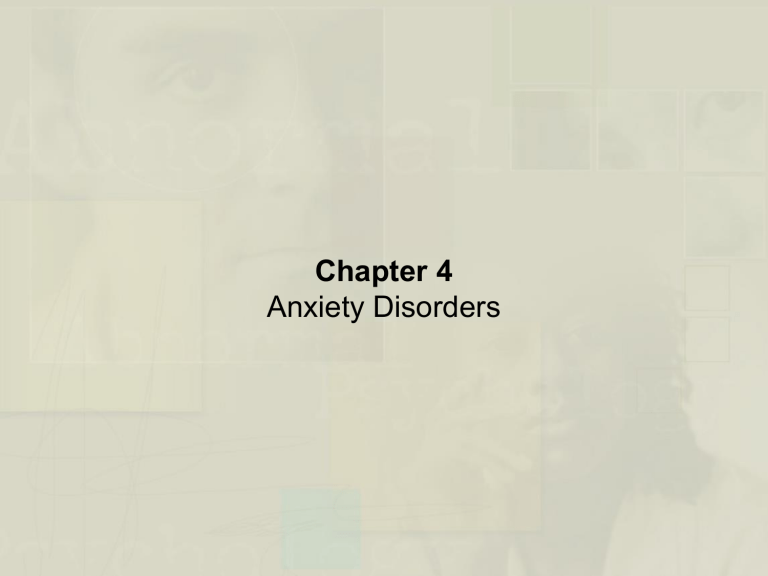
Chapter 4
Anxiety Disorders
Nature of Anxiety and Fear
• Fear – The Present-Oriented Mood State
– Immediate fight or flight response to danger or threat
– Involves abrupt activation of the sympathetic nervous system
– Strong avoidance/escapist tendencies
– Marked negative affect
Nature of Anxiety and Fear
• Anxiety – The Future-Oriented Mood State
– Apprehension about future danger or misfortune
– Somatic symptoms of tension
– Characterized by marked negative affect
• Anxiety and Fear are Normal Emotional
States
From Normal to Disordered Anxiety and Fear
• Characteristics of Anxiety Disorders
– Pervasive and persistent symptoms of anxiety and fear
– Involve excessive avoidance and escape
– Cause clinically significant distress and impairment
The Phenomenology of Panic Attacks
• What is a Panic Attack?
– Abrupt experience of intense fear or discomfort
– Several physical symptoms (e.g., breathlessness, chest pain)
– Fear as an alarm response
The Phenomenology of Panic Attacks
(continued)
• DSM-IV-TR Subtypes of Panic Attacks
– Situationally bound (cued)
– Unexpected (uncued)
– Situationally predisposed
Fig. 4.1, p. 126
Biological Contributions to Anxiety and
Panic
• Genetic Vulnerability
• Anxiety and brain circuits
– Depleted levels of GABA
• Corticotropin releasing factor (CRF) and
HYPAC axis
Biological Contributions to Anxiety and
Panic (continued)
• Limbic (amygdala) and the septalhippocampal systems
• Behavioral inhibition (BIS)
– Anxiety
• Fight/flight (FF) systems
– Fear
Psychological Contributions to Anxiety and
Fear
• Began with Freud
– Anxiety is a psychic reaction to fear
– Anxiety involves reactivation of an infantile fear situation
Psychological Contributions to Anxiety and
Fear (continued)
• Behavioral and Cognitive Views
– Invokes conditioning and cognitive explanations
– Anxiety and fear are learned responses
– Catastrophic thinking and appraisals play a role
Psychological Contributions to Anxiety and
Fear (continued)
• Early Childhood Contributions
– Experiences with uncontrollability and unpredictability
• Social Contributions
– Stressful life events trigger vulnerabilities
An Integrated Model
• Integrative View – Triple Vulnerability Model
– Generalized biological vulnerability
– Generalized psychological vulnerability
– Specific psychological vulnerability
An Integrated Model (continued)
• Common Processes: The Problem of
Comorbidity
– Comorbidity is common across the anxiety disorders
– Major depression is the most common secondary diagnoses
An Integrated Model (continued)
– About half of patients have two or more secondary diagnoses
– Comorbidity Suggests
• Common factors
• A relation between anxiety and depression
The Anxiety Disorders: An Overview
• Generalized Anxiety Disorder
• Panic Disorder with and without Agoraphobia
• Specific Phobias
• Social Phobia
• Posttraumatic Stress Disorder
• Obsessive-Compulsive Disorder
“Do you worry excessively about minor things?”
Fig. 4.3, p. 132
Generalized Anxiety Disorder: The “Basic”
Anxiety Disorder
• Overview and Defining Features
– Excessive uncontrollable anxious apprehension and worry
– Coupled with strong, persistent anxiety
– Persists for 6 months or more
– Somatic symptoms differ from panic (e.g., muscle tension)
Generalized Anxiety Disorder: The “Basic”
Anxiety Disorder (continued)
• Statistics
– Affects about 4% of the general population
– Females outnumber males approximately
2:1
– Onset is often insidious, beginning in early adulthood
– Very prevalent among the elderly
– Tends to run in families
Generalized Anxiety Disorder: Associated
Features and Treatment
• Associated Features
– Persons with GAD have been called
“autonomic restrictors”
– Fail to process emotional component of thoughts and images
• Treatment of GAD: Generally Weak
– Benzodiazapines – Often Prescribed
– Psychological interventions – Cognitive-
Behavioral Therapy
– Combined treatments – Acute vs. Long-
Term Outcomes
Fig. 4.4, p. 134
Panic Disorder With and Without
Agoraphobia
• Overview and Defining Features
– Experience of unexpected panic attack
(i.e., a false alarm)
– Develop anxiety, worry, or fear about another attack
– Many develop agoraphobia
Panic Disorder With and Without
Agoraphobia (continued)
• Facts and Statistics
– Affects about 3.5% of the general population
– Onset is often acute, beginning between
25 and 29 years of age
– 75% of individuals with agoraphobia are female
Panic Disorder: Associated Features and
Treatment
• Associated Features
– Nocturnal panic attacks – 60% panic during deep non-REM sleep
– Interoceptive/exteroceptive avoidance
• Medication Treatment
– Target serotonergic, noraadrenergic, and
GABA systems
– SSRIs (e.g., Prozac and Paxil) are preferred drugs
– Relapse rates are high following medication discontinuation
Panic Disorder: Associated Features and
Treatment (continued)
• Psychological and Combined Treatments
– Cognitive-behavior therapies are highly effective
– No evidence that combined treatment produces better outcome
– Best long-term outcome is with cognitivebehavior therapy alone
Specific Phobias: An Overview
• Overview and Defining Features
– Extreme irrational fear of a specific object or situation
– Persons will go to great lengths to avoid phobic objects
– Most recognize that the fear and avoidance are unreasonable
– Markedly interferes with one’s ability to function
Specific Phobias: An Overview (continued)
• Facts and Statistics
– Females are again over-represented
– Affects about 11% of the general population
– Phobias tend to run a chronic course
Specific Phobias: Associated Features and
Treatment
• Associated Features and Subtypes of
Specific Phobia
– Blood-injury-injection phobia – Unusual vasovagal response
– Situational phobia – Trains, planes, automobiles, closed spaces
– Natural Environment phobia – Natural events (e.g., heights, storms)
– Animal phobia – Animals and insects
– Separation Anxiety – Seen in children
Specific Phobias: Associated Features and
Treatment (continued)
• Causes of Phobias
– Biological and evolutionary vulnerability
– Three pathways -- Conditioning, observational learning, information
• Psychological Treatments of Specific Phobias
– Cognitive-behavior therapies are highly effective – Exposure
Fig. 4.8, p. 150
Social Phobia: An Overview
• Overview and Defining Features
– Extreme and irrational fear in social/performance situations
– Markedly interferes with one’s ability to function
– Often avoid social situations or endure them with great distress
– Generalized subtype – Affects many social situations
Social Phobia: An Overview (continued)
• Facts and Statistics
– Affects about 13% of the general population
– Prevalence is slightly greater in females than males
– Onset is usually during adolescence
– Peak age of onset at about 15 years
Social Phobia: Associated Features and
Treatment
• Causes
– Biological and evolutionary vulnerability
– Similar learning pathways as specific phobias
• Psychological Treatment
– Cognitive-behavioral treatment
– Cognitive-behavior therapies are highly effective
Social Phobia: Associated Features and
Treatment (continued)
• Medication Treatment
– Tricyclic antidepressants and monoamine oxidase inhibitors
– SSRIs Paxil, Zoloft, and Effexer – Are FDA approved
– Relapse rates are high following medication discontinuation
Posttraumatic Stress Disorder (PTSD): An
Overview
• Overview and Defining Features
– Main etiologic characteristics – Trauma exposure and response
– Reexperiencing (e.g., memories, nightmares, flashbacks)
– Avoidance
Posttraumatic Stress Disorder (PTSD): An
Overview (continued)
– Emotional numbing and interpersonal problems
– Markedly interferes with one's ability to function
– PTSD diagnosis – Only after 1 month posttrauma
Posttraumatic Stress Disorder (PTSD): An
Overview (continued)
• Statistics
– Combat and sexual assault are the most common traumas
– About 7.8% of the general population meet criteria for PTSD
Posttraumatic Stress Disorder (PTSD):
Causes and Associated Features
• Subtypes and Associated Features of PTSD
– Acute – May be diagnosed 1-3 months post trauma
– Chronic – Diagnosed after 3 months post trauma
– Delayed onset – Onset 6 months or more post trauma
– Acute stress disorder – PTSD immediately post-trauma
Posttraumatic Stress Disorder (PTSD):
Causes and Associated Features
(continued)
• Causes of PTSD
– Intensity of the trauma and one's reaction to it (i.e., true alarm)
– Learn alarms -- Direct conditioning and observational learning
– Biological vulnerability
– Uncontrollability and unpredictability
– Extent of social support, or lack thereof post-trauma
Posttraumatic Stress Disorder (PTSD):
Treatment
• Psychological Treatments
– Cognitive-behavior therapies (CBT) are highly effective
– CBT may include graduated or massed
(e.g., flooding) imaginal exposure
– Aim of CBT for PTSD
Obsessive-Compulsive Disorder (OCD): An
Overview
• Overview and Defining Features
– Obsessions - Intrusive and nonsensical thoughts, images, or urges
– Compulsions - Thoughts or actions to neutralize thoughts
– Vicious cycle of obsessions and compulsions
– Cleaning and washing or checking rituals are common
Obsessive-Compulsive Disorder (OCD):
Causes and Associated Features
• Statistics
– Affects about 2.6% of the general population
– Most with OCD are female
– Onset is typically in early adolescence or young adulthood
– OCD tends to be chronic
Obsessive-Compulsive Disorder (OCD):
Causes and Associated Features
(continued)
• Causes of OCD
– Parallels the other anxiety disorders
– Early life experiences
– Learning that some thoughts are dangerous/unacceptable
– Thought-action fusion -- The thought is similar to the action
Obsessive-Compulsive Disorder (OCD):
Treatment
•
Medication Treatment
– Clomipramine and other SSRIs – Benefit up to 60% of patients
– Relapse is common with medication discontinuation
– Psychosurgery (cingulotomy) is used in extreme cases
Obsessive-Compulsive Disorder (OCD):
Treatment (continued)
• Psychological Treatment
– Cognitive-behavioral therapy is most effective
– CBT involves exposure and response prevention
– Combining CBT with medication -- No better than CBT alone
Summary of the Anxiety Disorders
• Most Common Forms of Psychopathology
• From a Normal to a Disordered Experience of
Anxiety and Fear
– Triple Vulnerabilities – Bio-psycho-social
– Fear and anxiety – Non-dangerous bodily or environmental cues
– Symptoms and avoidance – Significant distress and impairment
Summary of the Anxiety Disorders
(continued)
• Psychological Treatments are Generally
Superior in the Long-Term
– Similar treatments for different anxiety disorders
– Suggests that anxiety-related disorders share common processes

